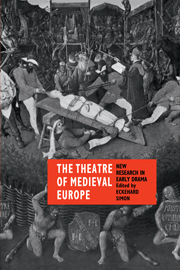Book contents
- Frontmatter
- Contents
- List of contributors
- Preface
- Note on the bibliography and system of references
- List of abbreviations for journals and series
- 1 Introduction: trends in international drama research
- PART I LATIN DRAMA
- PART II ENGLISH DRAMA
- 4 Modern editions of medieval English plays
- 5 The English mystery cycles
- 6 Castles in the air: the morality plays
- 7 ‘All the world was a stage’: Records of Early English Drama
- 8 The staging of medieval English plays
- PART III CONTINENTAL DRAMA
- Bibliography
- Author index to the bibliography
- General index
5 - The English mystery cycles
Published online by Cambridge University Press: 29 March 2011
- Frontmatter
- Contents
- List of contributors
- Preface
- Note on the bibliography and system of references
- List of abbreviations for journals and series
- 1 Introduction: trends in international drama research
- PART I LATIN DRAMA
- PART II ENGLISH DRAMA
- 4 Modern editions of medieval English plays
- 5 The English mystery cycles
- 6 Castles in the air: the morality plays
- 7 ‘All the world was a stage’: Records of Early English Drama
- 8 The staging of medieval English plays
- PART III CONTINENTAL DRAMA
- Bibliography
- Author index to the bibliography
- General index
Summary
Opening before God's creation of the world and closing after His final judgement of mankind, the mystery cycle is a sequential drama that flourished in many English towns and cities during the fourteenth, fifteenth and sixteenth centuries. Usually performed in one location on scaffold stages or in procession on movable wagons, the cycle was a major and often annual creation of its community, an expression of civic pride and piety, each individual pageant or play being the responsibility of one craft or religious guild. And the cycle is both a unique English play, bearing little direct connection with continental drama, and a unique product of the later Middle Ages, developing within an intellectual milieu that also witnessed the creation of summae, universal chronicles and other encyclopaedic forms.
Of the four extant English mystery cycles, the oldest is the N-Town cycle, a sequence of forty-one plays compiled in a manuscript dating from no earlier than 1468. Among its distinctive features is a group of five plays about Mary, actually a separate and self-contained composite Mary play, and a Passion sequence that is a single play from a separate manuscript incorporated by the scribe into the compilation. The N-Town cycle employs the two forms of staging, the movable wagons and the scaffold stages.
- Type
- Chapter
- Information
- The Theatre of Medieval EuropeNew Research in Early Drama, pp. 80 - 96Publisher: Cambridge University PressPrint publication year: 1991



